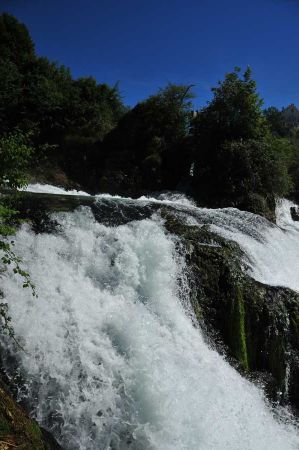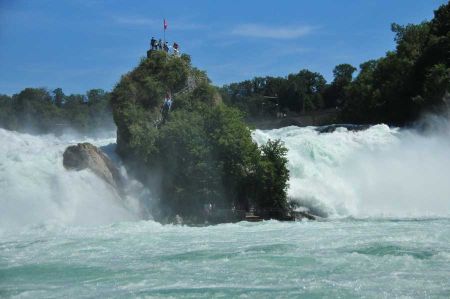Short stop at the Rhine Falls near Schaffhausen
- Written by Portal Editor
Our route to Zurich leads via Schaffhausen, so what could be more appropriate than to visit the Rhine Falls during the short drive from Rottweil. Short stop at the Swiss border with purchasing of the obligatory vignette to use the roads of Switzerland without any penalty.
Very well signposted there are two directions to the Rhine Falls, both of them offer great photo opportunities. We decide for the right bank of the Rhine in the Neuhausen district, which belongs to the canton of Schaffhausen, about four kilometers away to the city of Schaffhausen.
The Rhine itself was created during the last Ice Age as a meltwater runoff, as in the course of the general temperature drop 500,000 years ago, the landscape was designed by glacier movement in the Alps. Until about 200,000 years ago, at the end of the Rift Ice Age, the Rhine of Schaffhausen flowed west passing Klettgau, a riverbed that gradually silted up by depositing gravel from the Alps. Due to the deposits, the Rhine bed changed steadily until about 120,000 years ago, the Rhine was deflected at Schaffhausen to the south in the cracking Rhine gutter. During the Würm ice age, the Rhine bend was then moved further and further south, where it met hard Malmchalk (Weißjura) in the underground. At the point where the Malmchalk met again on the more easily drained soil of the cracking gravel channel, the Rhine Falls developed to the shape of today around 14,000 years ago, as can still be seen today.
You will notice from far away - the noise of the Rhine Fall
 Already on the way to the well-developed parking lot on the banks of the Rhine you can hear the loud roar of the Rhine Falls, misty clouds reflecting the sunlight. Imposing is the image that opens to us, despite the "just" 23 meter of height difference of the Rhine Falls, which does not seem really impressive from a distance. However, it must be huge amounts of water, which plummet at the impressive width of at least 150 meters in widsth. A little later we are in front of a first board, which provides more information. So we learn that at average water level of the Rhine about 373 cubic meters of water per second fall over the rocks of the Rhine Falls. The highest ever measured discharge was measured in 1965 at 1250 cubic meters per second. On average, the summer runoff is about 700 cubic meters per second. These are impressive numbers that you can barely represent in trucks, if you want to calculate the amount of water one day.
Already on the way to the well-developed parking lot on the banks of the Rhine you can hear the loud roar of the Rhine Falls, misty clouds reflecting the sunlight. Imposing is the image that opens to us, despite the "just" 23 meter of height difference of the Rhine Falls, which does not seem really impressive from a distance. However, it must be huge amounts of water, which plummet at the impressive width of at least 150 meters in widsth. A little later we are in front of a first board, which provides more information. So we learn that at average water level of the Rhine about 373 cubic meters of water per second fall over the rocks of the Rhine Falls. The highest ever measured discharge was measured in 1965 at 1250 cubic meters per second. On average, the summer runoff is about 700 cubic meters per second. These are impressive numbers that you can barely represent in trucks, if you want to calculate the amount of water one day.
We arrive at the viewing platform of the castle Wörth, from where you can use excursion boats directly to the Rhine Falls in the summer. The rock in the middle of the Rhine Falls is also provided with a viewing platform, which can be entered via narrow and steep stairs. Too late, seasonally, we are on site. None of the excursion boats is yet in operation. However, we learn that you can be brought by boat to the other side of the Rhine Falls to Castle Laufen, which lies on the Zurich side of the waterfall. At the next opportunity we plan to visit the Rhine Falls from this side. In the evening, when the Rhine Falls is illuminated by a lighting system, it must be awful to watch as well.
Eduard Mörike about his Impressions of the Rhine Falls
"Hold your heart, dear wanderer, firmly in mighty hands! Trembling with joy, mine almost crashed into mine. Restlessly thundering masses thrown on thunderous masses, ear and eye, where they save themselves in the turmoil ", so Eduard Mörike has written about his impressions at the Rhine Falls near Schaffhausen.
Of course, some myths have been formed throughout history. So the big climbable rock in the middle is considered a soul dance. In the vernacular, the Rhine Falls are called Great Run. There are many stories about the origin of this name. In addition to the twice as high but only half as water-rich Dettifoss waterfall on Iceland, the Rhine Falls is the largest waterfall in Europe.
Every now and then there are, even forbidden, some rather daredevil visitors who try to navigate the Rhine Falls with kayaks or Canadians and that despite considerable fines, which can amount up to 5,000 francs. Now and again you will find recordings of these activities on the Internet, a "recreational sport", which one should not operate better. Even for fish, the Rhine Falls are an insurmountable obstacle, except for the eel. But even the eel chooses the safe land route over the rocks to overcome the Rhine Falls, as has been repeatedly documented.
Please read as well:
Balaton - Lake Balcsi - not just an intermediate destination
The Ohrid Lake and its bubbling underground springs
-
 Rhinefall at Schaffhausen Switzerland
Rhinefall at Schaffhausen Switzerland
Rhinefall at Schaffhausen Switzerland
Rhinefall at Schaffhausen Switzerland
-
 Rhinefall at Schaffhausen Switzerland
Rhinefall at Schaffhausen Switzerland
Rhinefall at Schaffhausen Switzerland
Rhinefall at Schaffhausen Switzerland
-
 Rhinefall at Schaffhausen Switzerland
Rhinefall at Schaffhausen Switzerland
Rhinefall at Schaffhausen Switzerland
Rhinefall at Schaffhausen Switzerland
-
 Rhinefall at Schaffhausen Switzerland
Rhinefall at Schaffhausen Switzerland
Rhinefall at Schaffhausen Switzerland
Rhinefall at Schaffhausen Switzerland
-
 Rhinefall at Schaffhausen Switzerland
Rhinefall at Schaffhausen Switzerland
Rhinefall at Schaffhausen Switzerland
Rhinefall at Schaffhausen Switzerland
-
 Rhinefall at Schaffhausen Switzerland
Rhinefall at Schaffhausen Switzerland
Rhinefall at Schaffhausen Switzerland
Rhinefall at Schaffhausen Switzerland
-
 Rhinefall at Schaffhausen Switzerland
Rhinefall at Schaffhausen Switzerland
Rhinefall at Schaffhausen Switzerland
Rhinefall at Schaffhausen Switzerland
-
 Rhinefall at Schaffhausen Switzerland
Rhinefall at Schaffhausen Switzerland
Rhinefall at Schaffhausen Switzerland
Rhinefall at Schaffhausen Switzerland
-
 Rhinefall at Schaffhausen Switzerland
Rhinefall at Schaffhausen Switzerland
Rhinefall at Schaffhausen Switzerland
Rhinefall at Schaffhausen Switzerland
-
 Rhinefall at Schaffhausen Switzerland
Rhinefall at Schaffhausen Switzerland
Rhinefall at Schaffhausen Switzerland
Rhinefall at Schaffhausen Switzerland
-
 Rhinefall at Schaffhausen Switzerland
Rhinefall at Schaffhausen Switzerland
Rhinefall at Schaffhausen Switzerland
Rhinefall at Schaffhausen Switzerland
-
 Rhinefall at Schaffhausen Switzerland
Rhinefall at Schaffhausen Switzerland
Rhinefall at Schaffhausen Switzerland
Rhinefall at Schaffhausen Switzerland
-
 Rhinefall at Schaffhausen Switzerland
Rhinefall at Schaffhausen Switzerland
Rhinefall at Schaffhausen Switzerland
Rhinefall at Schaffhausen Switzerland
-
 Rhinefall at Schaffhausen Switzerland
Rhinefall at Schaffhausen Switzerland
Rhinefall at Schaffhausen Switzerland
Rhinefall at Schaffhausen Switzerland
-
 Rhinefall at Schaffhausen Switzerland
Rhinefall at Schaffhausen Switzerland
Rhinefall at Schaffhausen Switzerland
Rhinefall at Schaffhausen Switzerland
-
 Rhinefall at Schaffhausen Switzerland
Rhinefall at Schaffhausen Switzerland
Rhinefall at Schaffhausen Switzerland
Rhinefall at Schaffhausen Switzerland
-
 Rhinefall at Schaffhausen Switzerland
Rhinefall at Schaffhausen Switzerland
Rhinefall at Schaffhausen Switzerland
Rhinefall at Schaffhausen Switzerland
-
 Rhinefall at Schaffhausen Switzerland
Rhinefall at Schaffhausen Switzerland
Rhinefall at Schaffhausen Switzerland
Rhinefall at Schaffhausen Switzerland
-
 Rhinefall at Schaffhausen Switzerland
Rhinefall at Schaffhausen Switzerland
Rhinefall at Schaffhausen Switzerland
Rhinefall at Schaffhausen Switzerland
-
 Rhinefall at Schaffhausen Switzerland
Rhinefall at Schaffhausen Switzerland
Rhinefall at Schaffhausen Switzerland
Rhinefall at Schaffhausen Switzerland
-
 Rhinefall at Schaffhausen Switzerland
Rhinefall at Schaffhausen Switzerland
Rhinefall at Schaffhausen Switzerland
Rhinefall at Schaffhausen Switzerland
-
 Rhinefall at Schaffhausen Switzerland
Rhinefall at Schaffhausen Switzerland
Rhinefall at Schaffhausen Switzerland
Rhinefall at Schaffhausen Switzerland
-
 Rhinefall at Schaffhausen Switzerland
Rhinefall at Schaffhausen Switzerland
Rhinefall at Schaffhausen Switzerland
Rhinefall at Schaffhausen Switzerland
-
 Rhinefall at Schaffhausen Switzerland
Rhinefall at Schaffhausen Switzerland
Rhinefall at Schaffhausen Switzerland
Rhinefall at Schaffhausen Switzerland
-
 Rhinefall at Schaffhausen Switzerland
Rhinefall at Schaffhausen Switzerland
Rhinefall at Schaffhausen Switzerland
Rhinefall at Schaffhausen Switzerland
-
 Rhinefall at Schaffhausen Switzerland
Rhinefall at Schaffhausen Switzerland
Rhinefall at Schaffhausen Switzerland
Rhinefall at Schaffhausen Switzerland
-
 Rhinefall at Schaffhausen Switzerland
Rhinefall at Schaffhausen Switzerland
Rhinefall at Schaffhausen Switzerland
Rhinefall at Schaffhausen Switzerland
-
 Rhinefall at Schaffhausen Switzerland
Rhinefall at Schaffhausen Switzerland
Rhinefall at Schaffhausen Switzerland
Rhinefall at Schaffhausen Switzerland
-
 Rhinefall at Schaffhausen Switzerland
Rhinefall at Schaffhausen Switzerland
Rhinefall at Schaffhausen Switzerland
Rhinefall at Schaffhausen Switzerland
-
 Rhinefall at Schaffhausen Switzerland
Rhinefall at Schaffhausen Switzerland
Rhinefall at Schaffhausen Switzerland
Rhinefall at Schaffhausen Switzerland
-
 Rhinefall at Schaffhausen Switzerland
Rhinefall at Schaffhausen Switzerland
Rhinefall at Schaffhausen Switzerland
Rhinefall at Schaffhausen Switzerland
-
 Rhinefall at Schaffhausen Switzerland
Rhinefall at Schaffhausen Switzerland
Rhinefall at Schaffhausen Switzerland
Rhinefall at Schaffhausen Switzerland
-
 Rhinefall at Schaffhausen Switzerland
Rhinefall at Schaffhausen Switzerland
Rhinefall at Schaffhausen Switzerland
Rhinefall at Schaffhausen Switzerland
https://www.alaturka.info/en/switzerland/schaffhausen/4665-short-stop-at-the-rhine-falls-near-schaffhausen#sigProIdfa2b0e6b2f

